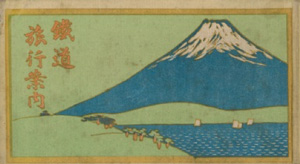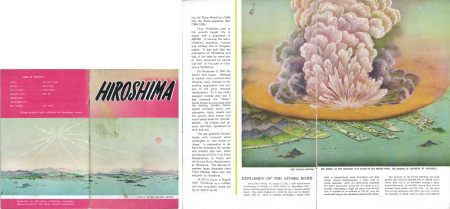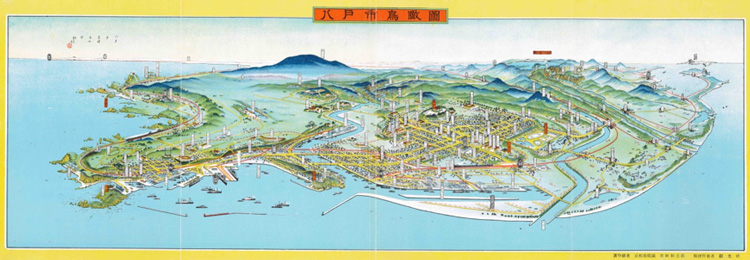- Until the Birth of A Bird’s-eye View PainterOpen or Close
In Meiji 17th (1884), Hatsusaburō was born in Nakagyō-ku, Kyoto City, lost his father at a young age and named himself Yoshida that is his mother’s surname. When Hatsusaburō who became a pioneer of commercial art later was born was a turning point when Japan was trying to systemize its art as a Japanese art history while Japan was trying to absorb Western contemporary art. He retraced that he was a boy who liked painting since childhood, got a deep impression by the anecdotes of Maruyama Ōkyo on a textbook and wanted to become a fine artist in the future. He went into service of Yūzen (a technique for dyeing on cloth) designer at the age of 10 and later, he worked for Yūzen section in Kyoto Mitsukoshi store. While he was a pride of his mother, he leaved alone to Tokyo with the saved money and a dream of becoming a genuine painter. Around Meiji 35th, he joined a western-style painting research group Hakuba-kai led by Kuroda Seiki et al. At that time, Okada Saburōsuke was an assistant professor, Wada Sanzō and others were belong to it.
However, about two years after the start of studying, the Russo-Japanese War broke out in Meiji 37th. And the following year, he was sent to the battlefield. After returning home from the Russo-Japanese War, he lived with his mother who was a widow and in Meiji 41st, he entered Kansai Bijutu In (an art school) and re-started the study of western-style painting. In this year, after finishing the second study in France, Kanokogi Takeshirō who was the authority of western-style paining in the west part of Japan became the director of the school and became the master of his life.
In Taishō 1st (1912), when he struggled in the way to become a painter, he was recommended the way of a commercial painter from his master, Kanokogi. Kanokogi knew the situation of France where artists worked on commercial designs such as advertisements, he felt the need to open the way to applied artists who work for society widely in Japan. He was able to create both of western and Japanese-style paintings and had an experience of graphic artist, he was an ideal person for that. Although it was a disappointing proposal for him who was aiming for fine art, he took the thought of his teacher and founded a company and set Kanokogi as its advisor. In addition to mural paintings of department stores, he got a certain evaluation soon at a politician's portrait and so on.
And in Taishō 2nd, by the request from Keihan Densha railway, he created the first bird’s-eye view painting “Keihan Densha Go-annai” (a guide map). Next year, this work got a praise by the Emperor Shōwa in the era of Prince as "beautiful and easy to understand". He had prided himself on the word of his Highness and dedicated his life to the country by paintings.
“Keihan Densha Go-annai”
The Famous Places along Keihan Railroad
(a renewal version of the maiden work in Taishō 2nd)
After Taishō 4th (1915~)
“Itukushima Shin-annai”
Itukushima New Guide
Taishō 4th (1915)
- A Bird’s-eye View Painting as a Key Mover of Travel BoomOpen or Close

"Tetudō Ryokō Annai”
Railway Travelling Guide
Taishō 10th (1921)Since the opening of the railroad between Shinbashi and Yokohama in Meiji 5th, Japan actively worked on the construction of railway networks, improvement of routes and construction of tourist facilities such as hotels and hot springs by the government and private companies. In Taishō 1st (1912), Japan Tourist Bureau (JTB) was established and government and private companies put efforts into attracting and mediating foreign tourists. Since the late Taishō era, people’s income had risen, leisure time was born and domestic travel boom by Japanese arrived. He just took on the wave of this travel boom and by the development of printing technology, he became to be asked to produce bird's-eye view paintings for travel guide from various people or places. And in Taishō 10th, the government of railways asked all of the illustrations over 100 for "Tetudō Ryokō Annai” (means, train travel guide) commemorating the 50th anniversary of railway opening. And this guide recorded a huge hit exceeding 40 editions. Since then, his reputation had grown and established its position as the foremost birds-eye view painter.

"Tetudō Ryokō Annai”
Railway Travelling Guide
Taishō 13th (1923)
He lived in Kyoto since Kanokogi's advice to be a commercial artist, but gradually the business got on track and set up an office in Ginza around Taishō 7th.
However, in Taishō 12th, when Hatsusaburō left Inuyama city, Aichi prefecture where he was staying after he painted the Nihon Line of the Kiso River by the request of the Nagoya Railroad, he got an information that the Tokyo office that had been the base at the time had collapsed due to the Great Kanto Earthquake. He received the provision of a house along the Kiso River from the Nagoya Railroad and set up a workshop that serve as its activity base in Inuyama for a period before moving to Hachinohe.

“Tenka no Zesshō Nihon Line Mēsho Zu-e”
The No.1 Superb View, Nihon Line
Taishō 12th (1922)
As seen in the voting of Nihon Hakkei (means, Japan's eight best spots) in Shōwa 2nd (1927) and the enforcement of the National Park Law in Shōwa 6th, the boom of sightseeing trip was accelerated in the Shōwa period and the travel guide bird's-eye view paintings became more vibrant and aroused the mood of traveling more. In Shōwa 5th, the International Tourism Bureau was established for the acquisition of foreign currency etc. And in the same year, he also worked on the first memorable poster whose purpose was to attract foreign tourists and issued to foreign countries.
Meanwhile, he had received a boost from Count Futara Yoshinori who was a chief secretary of Imperial Household earlier, and had worked on imperial and national institutions. At the time of the first army special exercise under Emperor Shōwa in Shōwa 2nd, "Birds-eye view of Aichi prefecture" was posted at the Imperial Headquarters. After that, even in special exercises in various places, his bird’s-eye view painting was posted customary.
“Shōwa 2-nen Rikugun Tokubetu Dai-enshū Kinen Aichi-ken Chōkan-zu”
Aichi Pref.
Shōwa 2nd (1927)
In such a peak of his success, after finishing the research and sketching of Lake Towada where was going to be a national park, in Shōwa 7th, he visited Hachinohe by the request of Hachinohe City. He admired Tanesashi coast as “the best view in Japan” where was superior to Cape Muroto where is one of the eight best view in Japan or Haegumgang in Korea.
- During and after World War Ⅱ, As a Bird’s-eye View PainterOpen or Close
Hatsusaburō moved his base in Hachinohe by Shōwa 11th (1936) but the next year, Japan-China War broke out and Japan went into the war regime until the end of Pacific War. By the change of law in Shōwa 12th, it became hard to make bird’s-eye view paintings. Moreover, the original paintings which were created over 20 years were confiscated and burned by the military police.
Hatsusaburō was disappointed but the war provided a role to painters. Many painters became to create war paintings to pay his debt to his country by a brush. A Japanese-style painting painter Yokoyama Taikan became the chairman of Dai-nihon Bijutsu Hōkoku Kai (means, great Japan art association to pay its debt to the country) drew Japanese mountains or rivers such as Mt. Fuji or rising sun to lead national unity. A western-style paining painter Fujita Tsuguharu served in the war and drew the battlefield in large campuses. After Shōwa 13th, Hatsusaburō also served in the war for several times and drew bird’s-eye view paintings of the battlefields.
During that time, Hatsusaburō had much parting, too. In Shōwa 12th, his mother Haru and in Shōwa 16th, his master Kanokogi passed away. Moreover, his sun and several of his disciples were killed in the war.
After the end of war, one request came to Hatsusaburō who had been grievously striken from a publishing company called Hiroshima Tosho. And he created 9 art works which shows the miserable damages by the atomic bomb such as the states of Hiroshima before and after the bomb, including the front picture of the magazine “HIROSHIMA”. And they are called “Genshi-baku-to Hiroshima Gafu” (means, the picture of Hiroshima where atomic bomb was dropped). He had visited Hiroshima from May Shōwa 21st, drawn sketches and taken interviews from over 200 atomic-bomb victims for several months. From this tenacity of purpose, we can feel the enthusiasm to pay his debt to his country by a brush, by a painter who had been drawing the beauty of Japan.
Magazine “HIROSHIMA”
In Shōwa 23rd, at the discussion with Prime Minister Ashida Hitoshi, Hatsusaburō got an encouragement from him as “Industry and tourism will underpin the revival of Japan. Contribute to the country by your bird’s-eye view paintings.” and started to create many art works. But in Shōwa 28th, “Chōkansō” (the name of his house/art studio) at Tanesashi was burned down by a neighboring fire. And in Shōwa 30th, he closed a curtain for a life of 71 at his house in Kyoto city.
On the magazine “Tabi to Mēsho” (means, travel and famous place) which published in June Shōwa 3rd, Hatsusaburō tells that “if I leave the paintings of famous places and pass down the relationships between those places and traffics or the state of development at the present time to the future, they will be the materials of history of civilization or would be an art genre as an unique paintings of famous places at the time”. A famous place is born by the history or climate of the region. Not only from the physical point of view, Hatsusaburō deeply understood the region where is the object of a painting. He included it in the art of unique paintings of famous places at that time and tried not only to use them for tourism but also remain them to the future. Then, the whole art works which were created through his lifetime is an art work which shows the beauty of Japan in the style of Hatsusaburō. At the present time when it is past 50 years after his death, because his art works are commercial arts, they remain until now and begin to come into the limelight again in the whole country as an art which amuse us and as a material which shows the history of the region.
“Hachinohe-shi Chōkan-zu”
Hachinohe City
Shōwa 29th (1964)
